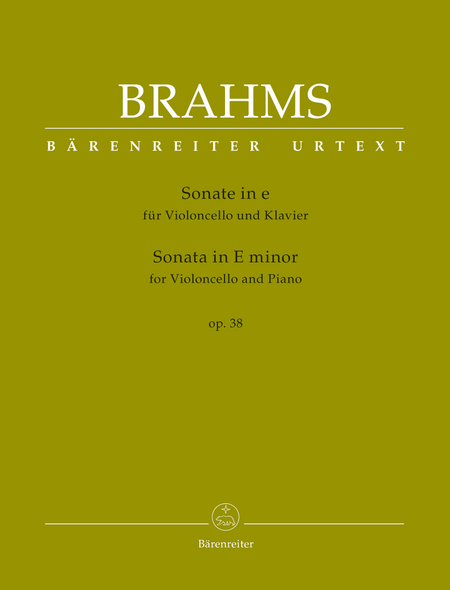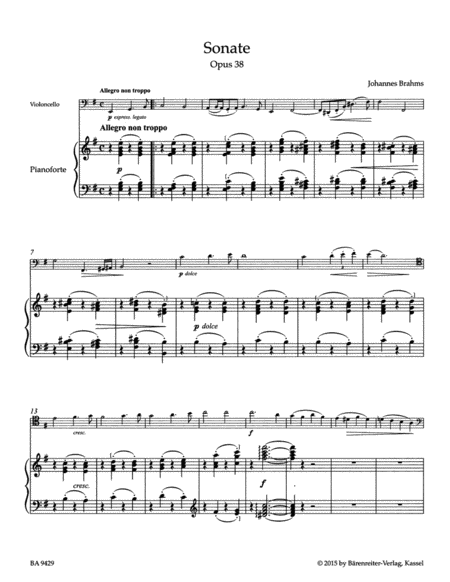Sonata for Violoncello and Piano E minor op. 38
-
Ships in 24 hours
Details
Description
SKU: BA.BA09429
Composed by Johannes Brahms. Edited by Clive Brown, Kate Bennett Wadsworth, and Neal Peres Da Costa. This edition: urtext edition. Stapled. Barenreiter Urtext. With an Urtext solo part by Clive Brown and a solo part with bowing and fingering by Kate Bennett Wadsworth; Fingering in the piano part by Neal Peres Da Costa; Performance Practice Commentary by C. Brown, N. P. Da Costa and K. B. Wadsworth. Score, Part. Opus 38. Baerenreiter Verlag #BA09429. Published by Baerenreiter Verlag (BA.BA09429).ISBN 9790006544295. 31 x 24.3 cm inches. Key: E minor. Language: German/English. Preface: Clive Brown.
The first three movements of Johannes Brahms’ E minor Cello Sonata were composed in 1862, the last movement was written in 1865. During the first years of its performance the work was received with mixed enthusiasm. By the end of Brahms’ life, however, it was widely performed and by the first decades of the 20th century it was firmly embedded in the repertoire of many distinguished cellists. It was notably Robert Hausmann’s advocacy of the work which seems to have contributed greatly to its promotion.
Of particular value to the editors were the three early performance editions of the Cello Sonata op. 38 by Cornelius van Vliet and Edwin Hughes, Hugo Becker and Carl Friedberg, as well as Julius Klengel. The cellists’ van Vliet, Becker and Klengel’s fingering and bowing allows for a better understanding of their performance practice. As such, the Bärenreiter edition comes with a cello part marked with fingering and bowing by the editors which are based on the practices of Brahms‘ contemporaries. We also provide an unmarked urtext part.
An important part of this edition is the extensive preface. Firstly it informs about the works‘ origins, early performances, its publication as well as early reception. Truly remarkable is the unique Performance Practice Commentary. Here the editors take the premise that already a few decades after Brahms‘ death a widening gulf developed between the composer’s expectations and the performance practices of the early 20th century. In a very concrete and practical way, the editors summarize some of the key issues in understanding Brahms‘ notation with regard to rhythm and timing, dynamics and accentuation, dots and strokes, slurring and non legato, piano pedalling and overholding, piano arpeggiation and dislocation, string instrument fingering, string instrument harmonics and vibrato. In this way, the edition offers an exciting and often surprising insight in Romantic musical interpretation.
Under Multimedia you will find audio samples from the individual movements of the sonata taken from the CD Deux-Elles DXL1181.
Johannes Brahms
Sonatas for Cello and Piano Op. 38 and Op. 99
Klavierstücke Op. 76
Kate Bennett Wadsworth, Violoncello
Yi-heng Yang, Piano
About Barenreiter Urtext
What can I expect from a Barenreiter Urtext edition?
MUSICOLOGICALLY SOUND
- A reliable musical text based on all available sources
- A description of the sources
- Information on the genesis and history of the work
- Valuable notes on performance practice
- Includes an introduction with critical commentary explaining source discrepancies and editorial decisions
... AND PRACTICAL
- Page-turns, fold-out pages, and cues where you need them
- A well-presented layout and a user-friendly format
- Excellent print quality
- Superior paper and binding


 Share
Share